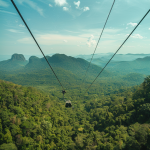Imagine being whisked up into the empyrean wonder of Thailand’s illustrious mountains, wrapped in a capsule of comfort, as you are catapulted directly into the arms of nature’s grandeur. This near-magical experience could soon become reality if the proposed cable car project at Phu Kradueng National Park breaks through the clouds of deliberation and onto the fertile grounds of approval.
The mention of a 28 million baht venture has set tongues wagging and minds racing, with the Thai cabinet nodding emphatically in agreement to nurture this discussion, during their retreat in the serene Nong Bua Lamphu province. It was a moment filled with anticipation, as the future of panoramic exploration hung delicately in balance.
The project, initially conjured as a rough sketch on the drawing board, requires the shrewd eye of Jatuporn Buruspat, the ministry’s permanent secretary, who will spearhead this odyssey of dialogue with agencies far and wide to capture a kaleidoscope of insights before pen is finally set to paper.
Puangpet Chunlaiad, a dynamo of decision-making attached to the Prime Minister’s Office, and a local sage hailing from the land of Loei, hinted at the tantalising possibility of this venture. Yet, the threading of these cables across skies is tied intricately to the yarn spun within the Budget Bureau — priorities, timelines, and decisions knitting together to form a jumper of judgement that will either warm the hearts of many or leave some out in the cold.
Before architectural blueprints become reality, and cable cars glide across the horizon, a microscopic gaze must fall upon the environmental, slicing through the fabric of potential impact. An Environmental Impact Assessment (EIA) must first receive the tender embrace of the Ministry of Natural Resources and Environment’s approval, before it can be paraded in front of the Ministry of Tourism and Sports, like a beauty pageant hopeful awaiting the crown.
Voices of concern from local residents initially echoed through the valleys. “Will our serene abode transform under the shadow of this behemoth?” they uttered in hushed tones. Nevertheless, the endearing Puangpet has since woven a narrative of unity and burgeoning opportunity, casting an enchanting spell that whispers of prosperity and visual feast. The idea of a cable car inviting one and all, especially the elderly, to partake in the panoramic ballet of clouds and earth, has softened hearts and promised a universal passport to the skies.
Set in the fertile crescent of Loei’s Phu Kradueng district, the national park unfurls its green tapestry over 348.13 square kilometers. Peaks swagger with might and majesty, with the zenith, Kok Moei, peering down from 1,316 meters above sea level with benevolent grace.
The dilemma of constructing a mechanical sky bridge into this utopia is not new. For years, the debate has swung like a pendulum, with proponents championing accessibility and environmental stewardship as ardent justifications, while critics cast a wary eye on the silent sentinels of flora and fauna, fearing the gentle hum of progress might disrupt their sanctuary.
For now, adventurers trace their way to the summit of Phu Kradueng by foot, with the main trail offering an 8.5-kilometer-long embrace, a journey through nature’s raw poetry that requires about 5 hours. Then there’s the Pha Sam Yaek trail – more a riddle wrapped in a mystery inside an enigma – 10 kilometers that challenge your mettle for a robust 6 to 8 hours.
Those seeking the summit’s embrace often enlist the local porters, the stalwart champions of the mountain, to bear their burdens upwards, ensuring every traveler can touch the sky. Yet, the question lingers in the crisp mountain air like a feather on the breeze — will the cable cars become chariots for the masses to the heavens, forever changing the Phu Kradueng tapestry? The answer, dear friends, is a whisper away, woven within the loom of time.


















Be First to Comment